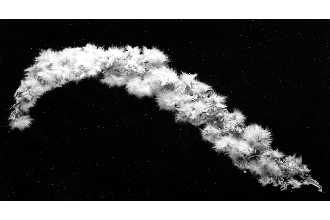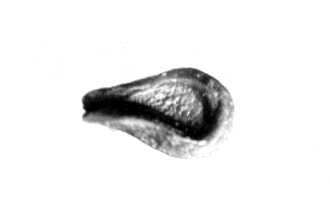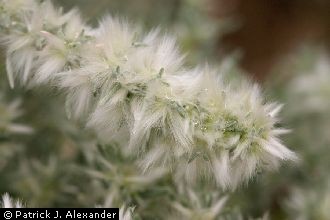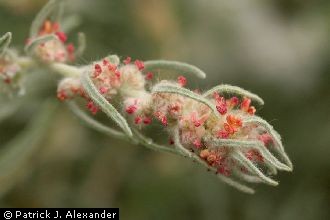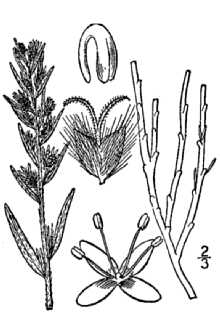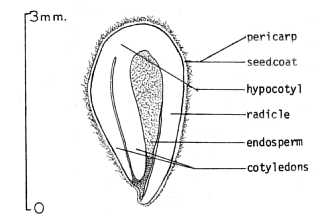Eurotia lanata (Pursh) Moq. var. subspinosa (Rydb.) Kearney & Peebles
Scientific Name: Eurotia lanata (Pursh) Moq. var. subspinosa (Rydb.) Kearney & Peebles
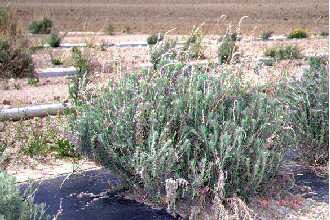
| General Information | |
|---|---|
| Usda Symbol | EULAS |
| Group | Dicot |
| Life Cycle | Perennial |
| Growth Habits | ShrubSubshrub, |
| Native Locations | EULAS |
Plant Guide
Alternate Names
White sage, winter-sage, feather-sage, sweet sage, lambstail, Eurotia lanata, and Ceratoides lanata , Use soil moisture sensors to measure the soil moisture of Eurotia lanata (Pursh) Moq. var. subspinosa (Rydb.) Kearney & Peebles.
Uses
Rangeland/Grazing – Winterfat is superior winter browse for livestock and wildlife. It is rated as excellent to good browse for cattle, sheep, and goats and fair browse for horses. It is one of the most valuable rangeland browse plants for maintaining the weight of adult animals on winter grazing ranges because of the high (>10 percent) crude protein content in winter. Wildlife – Winterfat is considered very good browse for wildlife and is extensively utilized by rodents, rabbits, antelope, deer, elk, and bighorn sheep. Erosion Control – Winterfat is a good erosion control plant when planted in a mixture to provide greater plant density. It has a deep taproot and an extensive fibrous root system near the soil surface, which helps stabilize soils. It germinates readily and provides fairly rapid growth under favorable growing conditions. Reclamation: Winterfat is an important pioneer species and establishes fairly easily on drastically disturbed sites or poorly developed soils such as those commonly found on mine lands.
Status
Consult the PLANTS Web site and your State Department of Natural Resources for this plant’s current status such as, state noxious status and wetland indicator values.
Description
Winterfat is an erect to spreading, low-growing, long-lived half-shrub native to the western United States. It is a cool season plant, typically with a central woody stem arising from a woody crown. Annual secondary stems, 8 inches to 4 feet and sometimes taller, are herbaceous on dwarf forms and herbaceous to woody throughout on taller forms, wooly and branched. Winterfat has an extensive fibrous root system and a deep penetrating taproot. Leaves are simple, alternate, mostly linear, and revolutely margined (rolled back from the margin). The inflorescence is a spike. Plants are monoecious with staminate flowers above the pistillate ones or occasionally they are dioecious. Pollination usually occurs between plants, but self-pollination may occur on monecious plants. Wind is the principal mode of pollination. The seed is a utricle and the seed coat is thin and covered with fine white, silky pilose hairs to ½ inch long.
Distribution
This plant is widely distributed from Saskatchewan and Manitoba, Canada to western Nebraska, Colorado, west Texas, California and Washington.
Adaptation
Winterfat is most common in the 7 to 16 inch annual precipitation zones, but has been found in areas with less than 6 inches of annual precipitation and in areas with greater than 20 inches annual precipitation. Winterfat is found from near sea level to 10,000 feet elevation. It occurs in salt desert shrub, pinyon juniper, sagebrush grass and near the edges of some forested plant communities. Winterfat grows well on a wide range of soil textures, although it prefers more basic or limy soils. It tolerates moderate to highly saline conditions, but is not tolerant of acidic soils. It does not tolerate flooding or extended wet conditions. Refer to soil surveys and ecological site descriptions for additional guidance. It generally has good cold tolerance with some accessions (see Northern Cold Desert Germplasm and Open Range Germplasm) being more tolerant. Active growth begins in early to mid spring, flowering occurs from mid spring to early summer, and seed maturity is reached by mid to late fall.
Establishment
Planting: Winterfat seed does not remain viable for extended periods and use of seed no older than two years is recommended. Winterfat seed may lose as much as 50 percent or more viability during the first year of storage. It is very important to have current germination test results for seed that is to be planted. Dormant fall - winter or very early spring plantings result in the best stands. Studies indicate that winterfat seedlings can survive freezing temperatures and do well at cool temperatures, but growth is very slow during hot summer periods. Winterfat utricles are covered with fine silky hairs that will not flow through a drill. . Debearded seed flows readily through a drill, but this seed (with hairs removed) may be viable for a shorter period of time than non-debearded seed. Winterfat should be seeded on the soil surface to no deeper than ¼ inch. Broadcasting seed on snow or broadcasting on a moist firm soil surface followed by a packing operation results in the best stands. Drilling seed from 1/16 to ¼ inch deep using a drill with good depth control and packer wheels into firm soil also results in satisfactory stands. When drill seeded alone to reclaim winterfat monoculture plant communities, 15 Pure Live seeds (PLS) per square foot (5.0 pounds PLS per acre) is recommended. If broadcast seeded, the seeding rate should be increased to 21 PLS seeds per square foot or 7.0 pounds PLS per acre. When seeded as a component of a mix, 0.025 to 0.5 pound PLS per acre drilled or 0.05 to 1.0 pound PLS per acre broadcast is recommended. Seeding in alternate or cross rows promotes optimum establishment of winterfat. A seeding rate of 1/40 (0.025) pound PLS per acre will result in approximately 400 plants per acre under favorable establishment and growing conditions. If winterfat is seeded in areas where annual weeds such as cheatgrass, medusahead rye, and/or tumble mustard are prevalent, it should be seeded in a mixture of adapted, vigorous native grasses following control practices such as tillage or herbicide treatment for the annual weeds.
Management
Winterfat has excellent tolerance to browsing during the winter. However, over-browsing has greatly reduced or eliminated it in some areas. No more than 25 percent of the annual season growth should be removed during the active growing period (less during active spring growth period) and no more than 50 percent of the annual season growth should be removed during dormant periods. New plantings should be excluded from browsing by livestock and wildlife until plants are well established and producing seed.
Environmental Concerns
Concerns
Concerns
Winterfat is native, long-lived, and spreads by seed distribution. It is not considered "weedy", but could slowly spread into adjoining vegetative communities under ideal climatic and environmental conditions. This species is well documented as having beneficial qualities and no negative impacts on wild or domestic animals.
Seed Production
Seed production fields can be established from transplants or by direct seeding. Establishing plants in a greenhouse and transplanting to the field will result in the most satisfactory stands for seed production. Plant spacing under transplant conditions should be 4 - 5 feet within row and a minimum of 5 feet between rows. Transplanting into weed barrier fabric can also improve plant establishment and seed production, weed control, and moisture conservation. Transplanting is recommended in the spring prior to hot summer temperatures. . Full seed production is usually reached the second to third year following transplanting. Plantings can also be established by direct seeding. A minimum of 15 to 20 PLS seeds per linear foot of drill row should be planted. Hand seeding in late fall or very early spring may also be an option. Plant 5 to 10 seeds in a close group at desired spacing and thin to 1 or 2 plants after emergence. Full seed production may be reached the third to fourth year following direct seeding. Winterfat requires an equivalent of 10 to 12 inches annual precipitation for seed production. Irrigation may only be needed for establishment. Expected seed yields may range from 200 to 400 pounds per acre. Fertilization is not generally recommended unless soil tests indicate severe nutrient deficiencies. Rabbits and rodents can damage stands and may destroy seedlings. Insects such as grasshoppers and Mormon crickets infrequently damage stands beyond recovery. Harvesting seed is best accomplished by hand stripping. Mechanized harvesting has been used, but seed requires additional conditioning to properly dry and clean excessive trash (leaves, stems, other inert matter). Harvested seed is usually threshed by debearding or run through a hammermill to remove the fine silky hairs that cover the seed followed by screening. This process greatly enhances the ability of the seed to flow through planting equipment. Removing the white hairs that surround the seed can injure the seed resulting in reduced viability, seedling vigor, and stand establishment. One must be extremely careful when threshing seed to limit the amount of mechanical action on the seed to minimize seed damage. Unthreshed seed is recommended for best stand establishment if hand seeding directly or for transplants. Viability of winterfat seed rapidly decreases after storage for 1 to 2 years even under the best storage conditions. Germination of fresh seed can be as high as 85 to 95 percent. Germination of seed 3 years or older is commonly below 25 percent. It is extremely important to have a current germination test for seed that will be planted. Seeds per pound will vary by accession, but averages 125,000 with bracts intact. Seed conditioned with a hammer-mill to remove bracts averages 200,000 seeds per pound. Cultivars, Improved and Selected Materials (and area of origin) Foundation and Registered seed is available through the appropriate state Crop Improvement Association or commercial sources to grow certified seed. ‘Hatch’ winterfat was released in 1985 by the USDA-NRCS Los Lunas Plant Materials Center in cooperation with New Mexico, Colorado, Utah, and Idaho Agricultural Experiment Stations, USDA-Forest Service, and Utah Division of
Wildlife
Resources. ‘Hatch’ was selected for improved seed production, germination, seedling vigor, and big game wildlife preference. ‘Hatch’ originated from the Hatch, Utah area at a site with 11 to 12 inches annual precipitation, 7300 feet elevation, and a mixed pinyon-juniper to mountain big sagebrush plant community. It performs well in New Mexico, Arizona, western Colorado, southern Utah, and southern Nevada. It is best adapted to upland sites and less adapted to arid desert shrub sites. Field plantings in the northern regions of the Great Basin and Intermountain West generally fail due to poor cold tolerance. Northern Cold Desert Germplasm Selected Class winterfat was released in 2001 by the USDA-NRCS Aberdeen Plant Materials Center and Idaho Agricultural Experiment Station. Northern Cold Desert Germplasm winterfat was selected for improved cold hardiness and is better adapted to the northern regions of the natural range of winterfat. Northern Cold Desert Germplasm winterfat is a composite of five accessions of winterfat. These accessions were selected from a collection of 45 accessions evaluated and found to be significantly more cold tolerant than others in the study. Source locations include a site southeast of Price, Utah; a site near Castledale, Utah; a site six miles east of Kanab, Utah; a site along Northfork Road in Washington County, Utah; and a site in Rio Blanco County, Colorado. The Northern Cold Desert Germplasm winterfat is an erect shrub that can grow to 3 feet tall with a 2 feet diameter canopy cover. It is better adapted to the colder, northern portions of the Great Basin and Intermountain West than Hatch. It tolerates very dry conditions in the 7 – 14 inch annual precipitation zone. It is highly tolerant of alkaline/saline soils and soils derived from limestone parent materials. Uses include rangeland restoration, erosion control, and browse for livestock and wildlife. Open Range Germplasm winterfat is a Tested Class germplasm released in 2002 by Bridger, Montana Plant Materials Center. It is a composite of three superior accessions from near Terry in Prairie County, Montana; near Bridger in Carbon County, Montana; and near Rawlins in Carbon County, Wyoming. Open Range Germplasm is adapted for use throughout the Northern Great Plains region including north-central U.S. and south-central Canada. Contact your local Natural Resources
Conservation
Service (formerly Soil Conservation Service) office for more information. Look in the phone book under ”United States Government.” The Natural Resources Conservation Service will be listed under the subheading “Department of Agriculture.”
References
Stevens, R., B. Giunta, K. Jorgensen, & A. Plummer 1977. Winterfat (Ceratoides lanata). Publication No. 77-2 Utah Division of Wildlife Resources. Federal Project W-82-R 1977. 41pp. Stevens, R., K. Jorgensen, S. Young, & S. Monsen, 1996. Forb and shrub seed production guide for Utah. Utah State University Extension AG 501. 51pp. Wasser, C. 1982. Ecology and culture of selected species useful in revegetating disturbed lands in the West. USDI Fish & Wildl. Serv. FWS/OBS-82/56. 347 pp.
Plant Traits
Growth Requirements
| Cold Stratification Required | No |
|---|---|
| Hedge Tolerance | Low |
| Hedge Tolerance | Low |
| Frost Free Days, Minimum | 90 |
| Frost Free Days, Minimum | 150 |
| Fire Tolerance | Medium |
| Fire Tolerance | Medium |
| Fertility Requirement | Low |
| Fertility Requirement | Low |
| Drought Tolerance | High |
| Drought Tolerance | High |
| Cold Stratification Required | No |
| Temperature, Minimum (°F) | -52 |
| CaCO3 Tolerance | High |
| CaCO3 Tolerance | High |
| Anaerobic Tolerance | None |
| Anaerobic Tolerance | None |
| Adapted to Medium Textured Soils | Yes |
| Adapted to Medium Textured Soils | Yes |
| Adapted to Fine Textured Soils | Yes |
| Adapted to Fine Textured Soils | Yes |
| Adapted to Coarse Textured Soils | Yes |
| Adapted to Coarse Textured Soils | Yes |
| Moisture Use | Low |
| Temperature, Minimum (°F) | -33 |
| Shade Tolerance | Intolerant |
| Shade Tolerance | Intermediate |
| Salinity Tolerance | High |
| Salinity Tolerance | High |
| Root Depth, Minimum (inches) | 12 |
| Root Depth, Minimum (inches) | 10 |
| Precipitation, Minimum | 8 |
| Precipitation, Minimum | 6 |
| Precipitation, Maximum | 20 |
| Precipitation, Maximum | 16 |
| Planting Density per Acre, Minim | 700 |
| Planting Density per Acre, Minim | 700 |
| Planting Density per Acre, Maxim | 1200 |
| Planting Density per Acre, Maxim | 1200 |
| pH, Minimum | 6.6 |
| pH, Minimum | 6.6 |
| pH, Maximum | 8.5 |
| pH, Maximum | 8.3 |
| Moisture Use | Low |
Morphology/Physiology
| Active Growth Period | Summer |
|---|---|
| Toxicity | None |
| Toxicity | None |
| Shape and Orientation | Erect |
| Fire Resistant | No |
| Foliage Texture | Medium |
| Foliage Texture | Coarse |
| Foliage Porosity Winter | Porous |
| Foliage Porosity Winter | Moderate |
| Foliage Porosity Summer | Moderate |
| Foliage Porosity Summer | Dense |
| Foliage Color | White-Gray |
| Foliage Color | Green |
| Flower Conspicuous | No |
| Flower Conspicuous | No |
| Flower Color | Yellow |
| Flower Color | White |
| Resprout Ability | Yes |
| Fire Resistant | No |
| Fall Conspicuous | No |
| Fall Conspicuous | No |
| Coppice Potential | No |
| Coppice Potential | No |
| C:N Ratio | Low |
| C:N Ratio | Low |
| Bloat | None |
| Bloat | None |
| Active Growth Period | Spring |
| Shape and Orientation | Erect |
| Fruit/Seed Color | White |
| Resprout Ability | Yes |
| Nitrogen Fixation | None |
| Nitrogen Fixation | None |
| Low Growing Grass | No |
| Low Growing Grass | No |
| Lifespan | Long |
| Lifespan | Long |
| Leaf Retention | Yes |
| Leaf Retention | Yes |
| Known Allelopath | No |
| Known Allelopath | No |
| Height, Mature (feet) | 2.0 |
| Height, Mature (feet) | 2.0 |
| Fruit/Seed Color | Blue |
| Fruit/Seed Conspicuous | No |
| Fruit/Seed Conspicuous | Yes |
| Growth Form | Multiple Stem |
| Growth Form | Multiple Stem |
| Growth Rate | Moderate |
| Growth Rate | Rapid |
| Height at 20 Years, Maximum (fee | 1 |
| Height at 20 Years, Maximum (fee | 2 |
Reproduction
| Propagated by Cuttings | Yes |
|---|---|
| Propagated by Seed | Yes |
| Propagated by Seed | Yes |
| Propagated by Sod | No |
| Propagated by Sod | No |
| Propagated by Sprigs | No |
| Propagated by Sprigs | No |
| Propagated by Tubers | No |
| Propagated by Tubers | No |
| Seed per Pound | 110729 |
| Fruit/Seed Period End | Fall |
| Seed per Pound | 123000 |
| Seed Spread Rate | Moderate |
| Seed Spread Rate | Rapid |
| Seedling Vigor | High |
| Seedling Vigor | Medium |
| Small Grain | No |
| Small Grain | No |
| Vegetative Spread Rate | Moderate |
| Vegetative Spread Rate | None |
| Propagated by Corm | No |
| Propagated by Cuttings | Yes |
| Bloom Period | Early Summer |
| Bloom Period | Spring |
| Commercial Availability | Routinely Available |
| Commercial Availability | Routinely Available |
| Fruit/Seed Abundance | High |
| Fruit/Seed Abundance | Medium |
| Fruit/Seed Period Begin | Summer |
| Fruit/Seed Period Begin | Summer |
| Fruit/Seed Period End | Fall |
| Fruit/Seed Persistence | Yes |
| Propagated by Bare Root | Yes |
| Propagated by Bare Root | Yes |
| Propagated by Bulb | No |
| Propagated by Bulb | No |
| Propagated by Container | Yes |
| Propagated by Container | Yes |
| Propagated by Corm | No |
| Fruit/Seed Persistence | Yes |
Suitability/Use
| Palatable Browse Animal | High |
|---|---|
| Palatable Graze Animal | High |
| Palatable Graze Animal | Medium |
| Palatable Human | No |
| Palatable Human | No |
| Post Product | No |
| Post Product | No |
| Protein Potential | High |
| Protein Potential | High |
| Pulpwood Product | No |
| Pulpwood Product | No |
| Veneer Product | No |
| Veneer Product | No |
| Palatable Browse Animal | High |
| Nursery Stock Product | No |
| Nursery Stock Product | No |
| Naval Store Product | No |
| Naval Store Product | No |
| Lumber Product | No |
| Lumber Product | No |
| Fodder Product | Yes |
| Fodder Product | Yes |
| Christmas Tree Product | No |
| Christmas Tree Product | No |
| Berry/Nut/Seed Product | No |
| Berry/Nut/Seed Product | No |
